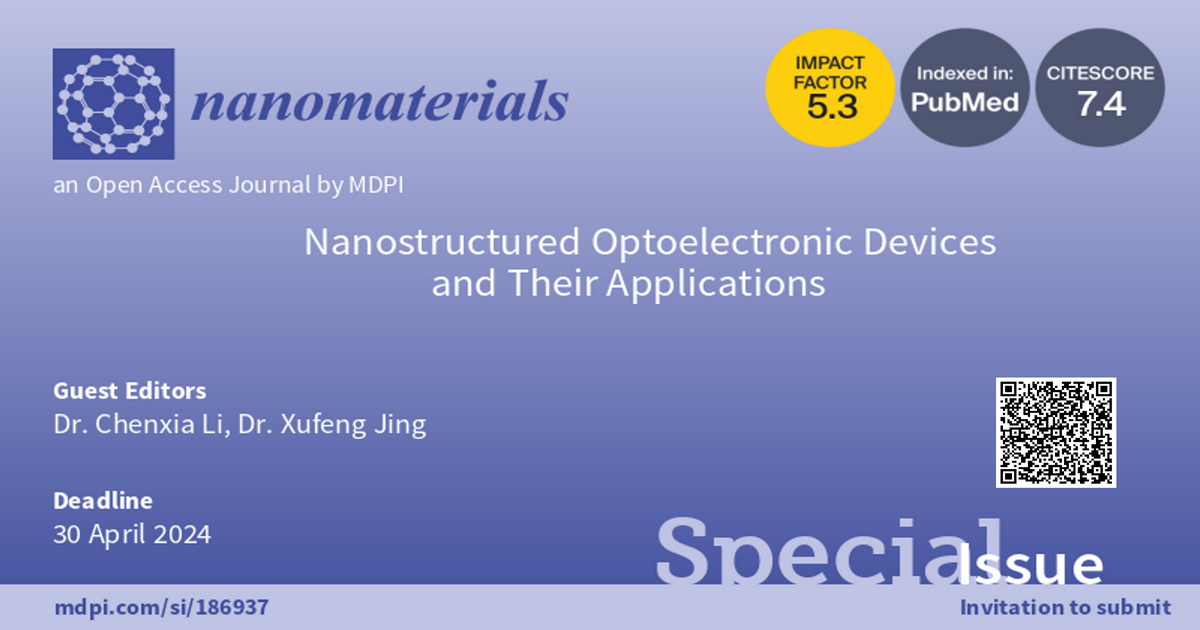Nanostructured Optoelectronic Devices and Their Applications
A special issue of Nanomaterials (ISSN 2079-4991). This special issue belongs to the section "Nanophotonics Materials and Devices".
Deadline for manuscript submissions: closed (30 April 2024) | Viewed by 1182

Special Issue Editors
Interests: optoelectronic materials and device; metamaterials; metasurfaces
Special Issues, Collections and Topics in MDPI journals
Interests: optoelectronic materials and devices; metamaterials; metasurfaces
Special Issues, Collections and Topics in MDPI journals
Special Issue Information
Dear Colleagues,
Micro/nano-optics is an optical branch that has developed rapidly in recent years, covering almost all fields of optics including metamaterials, surface plasmons, microcavities, microrings, near-field imaging, and superlenses, and its performance is also noteworthy. With the development of science and technology, micro- and nano-optics are becoming more and more important. Micro/nano-optics is the study of the design, manufacture and application of optical components (light emission, transmission, transformation and reception) with micrometer/nanometer characteristic dimensions. Micro- and nano-optics is one of the most active fields in the development of optical technology, which combines the cutting-edge achievements of photonics and micro- and nanotechnology. Topics of interest for this Special Issue include, but are not limited to, the following:
- Super-resolution imaging;
- Photoelectric devices;
- Metamaterials;
- Metasurfaces;
- Light field manipulation.
Dr. Chenxia Li
Dr. Xufeng Jing
Guest Editors
Manuscript Submission Information
Manuscripts should be submitted online at www.mdpi.com by registering and logging in to this website. Once you are registered, click here to go to the submission form. Manuscripts can be submitted until the deadline. All submissions that pass pre-check are peer-reviewed. Accepted papers will be published continuously in the journal (as soon as accepted) and will be listed together on the special issue website. Research articles, review articles as well as short communications are invited. For planned papers, a title and short abstract (about 100 words) can be sent to the Editorial Office for announcement on this website.
Submitted manuscripts should not have been published previously, nor be under consideration for publication elsewhere (except conference proceedings papers). All manuscripts are thoroughly refereed through a single-blind peer-review process. A guide for authors and other relevant information for submission of manuscripts is available on the Instructions for Authors page. Nanomaterials is an international peer-reviewed open access semimonthly journal published by MDPI.
Please visit the Instructions for Authors page before submitting a manuscript. The Article Processing Charge (APC) for publication in this open access journal is 2900 CHF (Swiss Francs). Submitted papers should be well formatted and use good English. Authors may use MDPI's English editing service prior to publication or during author revisions.
Keywords
- photoelectric device
- optical material
- micro/nano-optics
- optoelectronic devices
- sensor techniques
Benefits of Publishing in a Special Issue
- Ease of navigation: Grouping papers by topic helps scholars navigate broad scope journals more efficiently.
- Greater discoverability: Special Issues support the reach and impact of scientific research. Articles in Special Issues are more discoverable and cited more frequently.
- Expansion of research network: Special Issues facilitate connections among authors, fostering scientific collaborations.
- External promotion: Articles in Special Issues are often promoted through the journal's social media, increasing their visibility.
- e-Book format: Special Issues with more than 10 articles can be published as dedicated e-books, ensuring wide and rapid dissemination.
Further information on MDPI's Special Issue polices can be found here.







